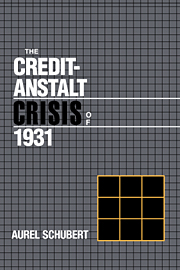Book contents
- Frontmatter
- Contents
- Tables
- Preface
- The Credit-Anstalt Crisis of 1931
- 1 Introduction
- 2 Diary of the crisis
- 3 Financial crisis theories and the Austrian experience of 1931
- 4 The causes of the financial crisis
- 5 The financial crisis and market efficiency
- 6 The financial crisis and economic activity
- 7 The financial crisis and the lender of last resort
- 8 Alternative policies and policy implications
- 9 Conclusions
- Bibliography
- Index
6 - The financial crisis and economic activity
Published online by Cambridge University Press: 20 March 2010
- Frontmatter
- Contents
- Tables
- Preface
- The Credit-Anstalt Crisis of 1931
- 1 Introduction
- 2 Diary of the crisis
- 3 Financial crisis theories and the Austrian experience of 1931
- 4 The causes of the financial crisis
- 5 The financial crisis and market efficiency
- 6 The financial crisis and economic activity
- 7 The financial crisis and the lender of last resort
- 8 Alternative policies and policy implications
- 9 Conclusions
- Bibliography
- Index
Summary
Financial crises, like contagious disease, threaten not only the host organism, namely the financial market, but the entire economic environment in which the host resides.
–Eichengreen and Postes, 1987The evidence and the channels of transmission
The banking and currency crisis of 1931 clearly coincided with adverse developments in economic activity in Austria. Historic accounts point out that after sharp drops in output and large increases in unemployment during 1930, in the spring of 1931 the trough seemed to have been passed, and a slow recovery seemed to be on its way. The Austrian Chancellor Ender stated in March 1931, during a parliamentary session, that for Austria the trough of the economic depression had already been reached (Kernbauer et al. 1983, 378), and the press frequently announced an easing of the crisis. The highly respectable Austrian Institute for Business Cycle Research (“Oesterreichisches Institut für Konjunkturforschung”) pointed out repeatedly that the crisis had started to fade away (OlfK, February 26, 1932, 17), that the first symptoms of recovery had appeared, and that a considerable improvement had occurred in the securities market (OlfK, 1933, 6). In April 1931, the first large domestic bond issue since World War I, the Austrian Housing Loan, turned out to be a great success. It was more than 50 percent oversubscribed, and as The Times (April 14, 1931, 21) reported, it was “taken to herald the success of any forthcoming Austrian issues abroad.”
- Type
- Chapter
- Information
- The Credit-Anstalt Crisis of 1931 , pp. 98 - 140Publisher: Cambridge University PressPrint publication year: 1992



